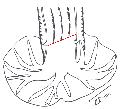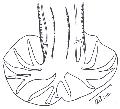Descripteur : Disappearance of the cuticular ridges in the male
The great majority of Trichostongylina possess longitudinal or oblique orientated cuticular ridges on the outer surface of the body. These cuticular ridges (synlophe) functions in locomotion or in the attachment of the worm to the host.
In the Heligmonellinae males, the ridges can disappear either before reaching the caudal bursa, or on the level of the caudal bursa.


